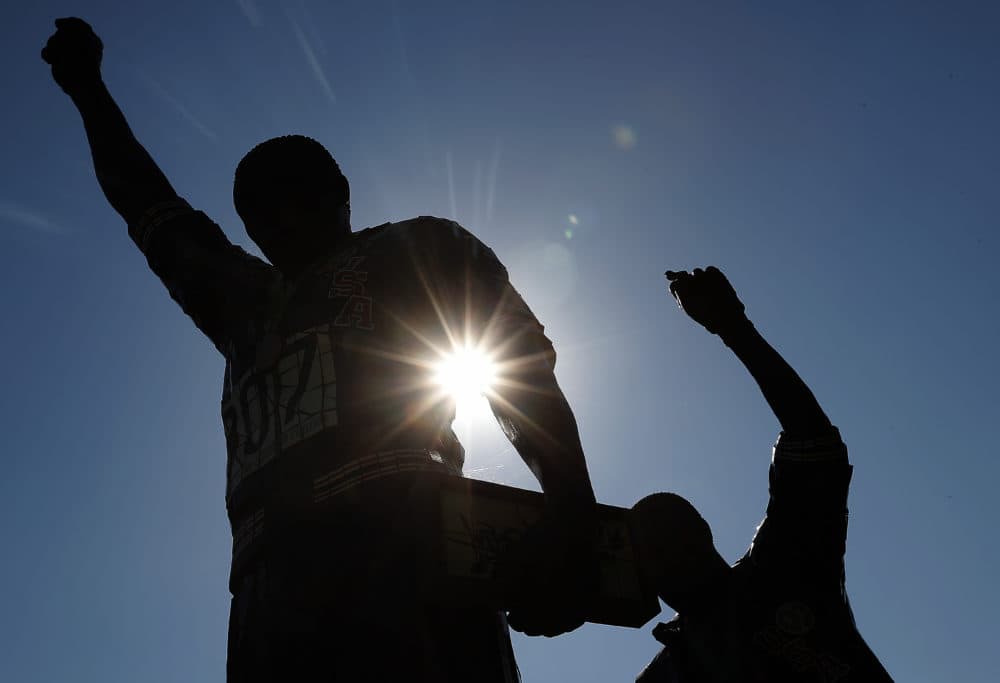Advertisement
On The Events Of 1968 And The Purpose Of Protest

I was 13 years old and watching on a black-and-white Magnavox in our Los Angeles basement. As a 10 year old, I had seen the Watts riots close up and have an everlasting memory of National Guard troops staging in the Crenshaw Shopping Center while my mother rushed me past a machine-gun-mounted Jeep to buy groceries at Vons Market.
My entire life had been lived in the background of the national fight for civil rights and major global events: bus boycotts, marches in Washington, the space race and the Cuban missile crisis. That was a black baby boomer coming-of-age chronology.
That summer, James Brown released “Say it Loud, I’m Black and I’m Proud.” Among all of the other changes of puberty, I was no longer Negro but black and swept up in a full-blown Black Power movement. The prism for me of the 1968 Olympic protest was a moment of pride and empowerment.
Much like many today in regards to NFL players kneeling to protest social justice issues, the anti-patriotism angle is not what I saw. Don’t get me wrong — I understand the analysis. I better see it as a conundrum: If you don’t protest in a way that causes discomfort, you won’t get the attention needed to highlight your issue.
Without a doubt, there was no moment bigger than the Olympics in terms of attention. After all, these were the first Games that were broadcast in color. Also, the patriotic aura of the Olympics in 1968 was today’s environment on steroids. Looking back, there was no bigger, connected moment to protest the issues concerning the Olympic Project For Human Rights. Looking back, the only bigger moment could have been on the victory stand for the men’s 100 meters, the race that crowns the world’s fastest human. But the 200 was more than adequate.
On Thursday, Oct. 17, 1968, we were back at Audubon Junior High School. Everybody in gym class wanted to be John Carlos or Tommie Smith. They were bad men. In our community, we knew what they were saying and that they were speaking for all of us. Fifty years ago, it was Black Power versus patriotism, a framing that conflicts many of us today with the social justice protests of the NFL: “I believe in social justice, but that flag thing ...”
The irony today is the best known athlete activist of the moment, Colin Kaepernick, now has a Nike advertising campaign. John Carlos, Tommie Smith and even Peter Norman — the white guy on the victory stand — spent years trying to get their lives back on track after that protest. None of them ever had a major apparel deal accompanying their activism.
Advertisement
Like the long road of societal-acceptance rehab that brought anti-war protester Muhammad Ali to the forefront of athlete heroes, the road Smith and Carlos have taken took a turn upward as well. Overall, 50 years later, this is a time of celebration where the purpose of the protest is much more clearly grasped by all. More of us can see it now. But I still see it through the eyes of a 13 year old praying for an equal chance and respect in the world ahead.
Kenneth Shropshire is a professor of Global Sport and the CEO of the Global Sport Institute at Arizona State University. A longer version of this essay was written for GlobalSportMatters.com.
This essay appears as part of a special episode of Only A Game devoted to athletes and protest.
This segment aired on October 27, 2018.

